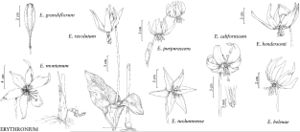Erythronium revolutum
in A. Rees, Cycl. 13: Erythronium no. 3. 1809.
Bulbs narrowly ovoid, 35–50 mm, sometimes producing sessile offsets. Leaves 10–25 mm; blade distinctly mottled with irregular streaks of brown or white, broadly lanceolate to ovate, margins entire to ± wavy. Scape 15–40 cm. Inflorescences 1–3-flowered. Flowers: tepals uniformly clear violet-pink at anthesis, with yellow banding at base, lanceolate to narrowly elliptic, 25–40 mm, inner with small auricles at base; stamens ± appressed to style, 12–22 mm; filaments white to pink (darkening with age), flattened, ± lanceolate, 2–3 mm wide; anthers bright yellow; style white to pink, 12–18 mm; stigma with slender recurved lobes 4–6 mm. Capsules oblong to obovoid, 3–6 cm.
Phenology: Flowering early spring (Mar–Apr).
Habitat: Shaded stream banks, river terraces, wet places in forests
Elevation: 0–600(–1000) m
Distribution

B.C., Calif., Oreg., Wash., generally within 100 km of Pacific Coast.
Discussion
Selected References
None.
